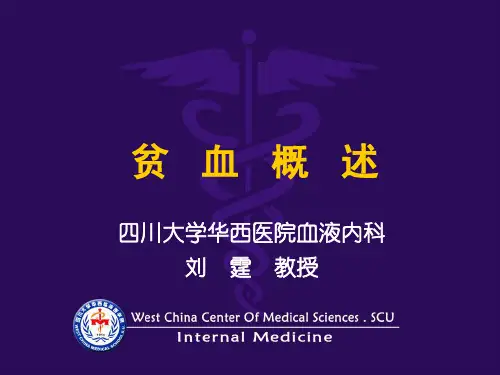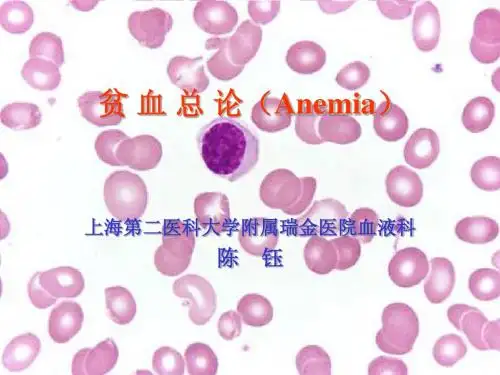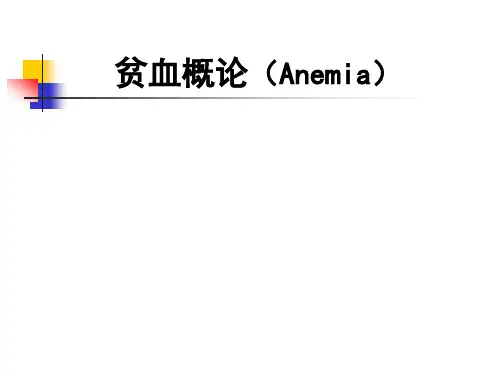内科学:贫血概论(Anemia)
- 格式:ppt
- 大小:12.97 MB
- 文档页数:31
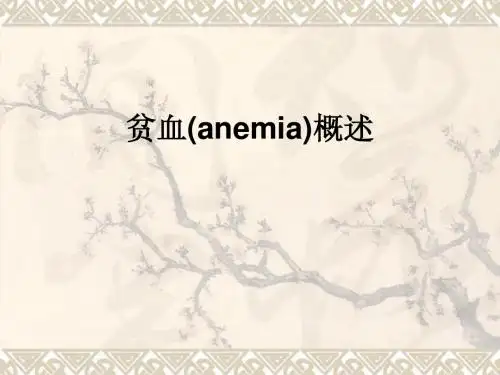


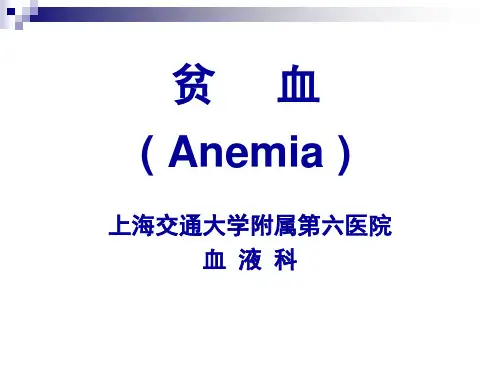
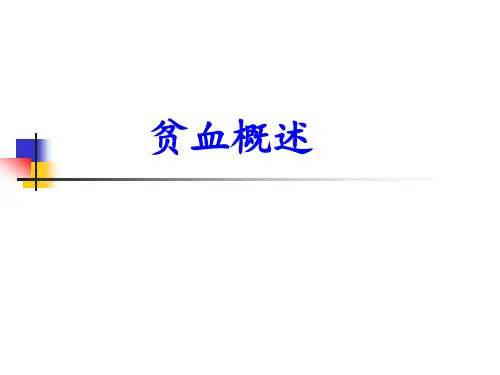
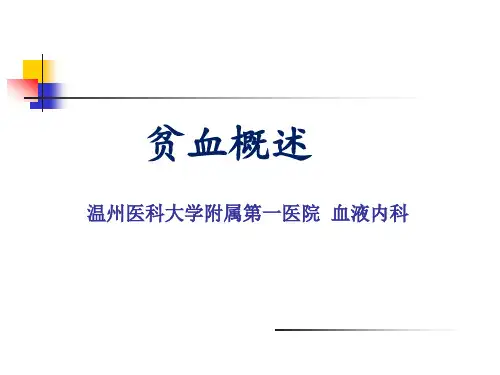
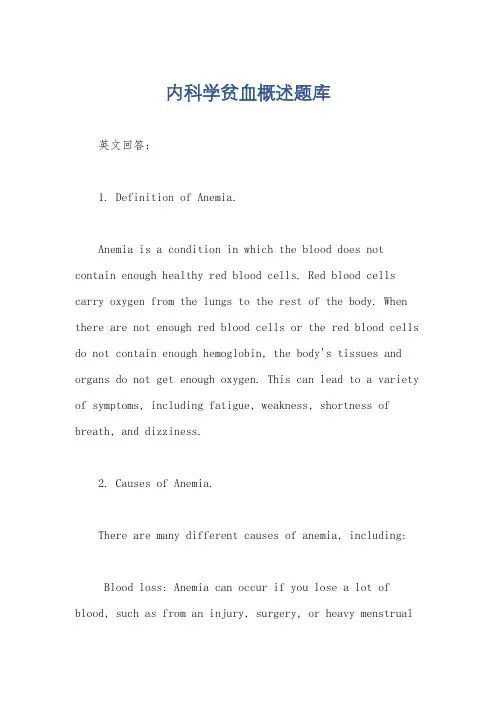
内科学贫血概述题库英文回答:1. Definition of Anemia.Anemia is a condition in which the blood does not contain enough healthy red blood cells. Red blood cells carry oxygen from the lungs to the rest of the body. When there are not enough red blood cells or the red blood cells do not contain enough hemoglobin, the body's tissues and organs do not get enough oxygen. This can lead to a variety of symptoms, including fatigue, weakness, shortness of breath, and dizziness.2. Causes of Anemia.There are many different causes of anemia, including:Blood loss: Anemia can occur if you lose a lot of blood, such as from an injury, surgery, or heavy menstrualbleeding.Iron deficiency: Iron is a mineral that is essential for the production of hemoglobin. If you do not get enough iron in your diet, you can develop iron deficiency anemia.Vitamin B12 deficiency: Vitamin B12 is a vitamin that is also essential for the production of red blood cells. If you do not get enough vitamin B12 in your diet, you can develop vitamin B12 deficiency anemia.Folic acid deficiency: Folic acid is a vitamin that is also essential for the production of red blood cells. If you do not get enough folic acid in your diet, you can develop folic acid deficiency anemia.Chronic diseases: Some chronic diseases, such as cancer, kidney disease, and rheumatoid arthritis, can lead to anemia.Medications: Some medications, such as chemotherapy drugs and certain antibiotics, can cause anemia.3. Symptoms of Anemia.The symptoms of anemia can vary depending on the severity of the condition. Some of the most common symptoms include:Fatigue.Weakness.Shortness of breath.Dizziness.Lightheadedness.Pale skin.Cold hands and feet.Brittle nails.Irregular heartbeat.Chest pain.4. Diagnosis of Anemia.Anemia is diagnosed with a blood test. The blood test will measure the number of red blood cells, the amount of hemoglobin in the red blood cells, and the size and shape of the red blood cells.5. Treatment of Anemia.The treatment for anemia depends on the cause of the condition. Some common treatments include:Iron supplements: If you have iron deficiency anemia, you will need to take iron supplements to increase your iron levels.Vitamin B12 supplements: If you have vitamin B12deficiency anemia, you will need to take vitamin B12 supplements to increase your vitamin B12 levels.Folic acid supplements: If you have folic acid deficiency anemia, you will need to take folic acid supplements to increase your folic acid levels.Blood transfusions: If you have severe anemia, you may need a blood transfusion to increase your red blood cell count.Medications: If you have anemia caused by a chronic disease, you may need to take medications to treat the underlying disease.中文回答:1. 贫血的定义。
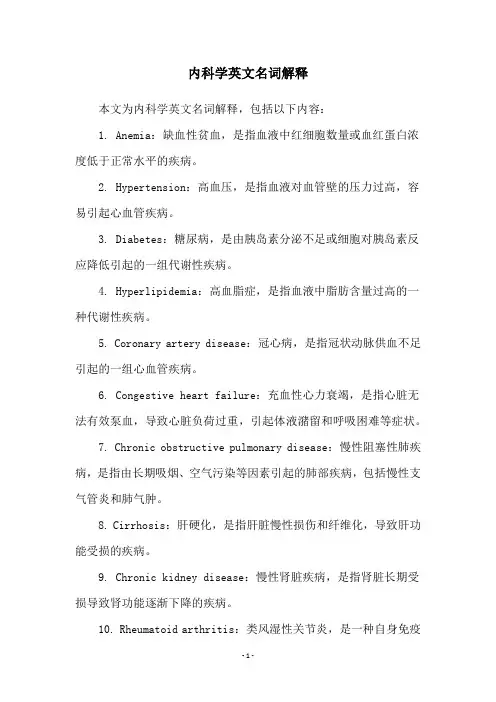
内科学英文名词解释
本文为内科学英文名词解释,包括以下内容:
1. Anemia:缺血性贫血,是指血液中红细胞数量或血红蛋白浓度低于正常水平的疾病。
2. Hypertension:高血压,是指血液对血管壁的压力过高,容易引起心血管疾病。
3. Diabetes:糖尿病,是由胰岛素分泌不足或细胞对胰岛素反应降低引起的一组代谢性疾病。
4. Hyperlipidemia:高血脂症,是指血液中脂肪含量过高的一种代谢性疾病。
5. Coronary artery disease:冠心病,是指冠状动脉供血不足引起的一组心血管疾病。
6. Congestive heart failure:充血性心力衰竭,是指心脏无法有效泵血,导致心脏负荷过重,引起体液潴留和呼吸困难等症状。
7. Chronic obstructive pulmonary disease:慢性阻塞性肺疾病,是指由长期吸烟、空气污染等因素引起的肺部疾病,包括慢性支气管炎和肺气肿。
8. Cirrhosis:肝硬化,是指肝脏慢性损伤和纤维化,导致肝功能受损的疾病。
9. Chronic kidney disease:慢性肾脏疾病,是指肾脏长期受损导致肾功能逐渐下降的疾病。
10. Rheumatoid arthritis:类风湿性关节炎,是一种自身免疫
性疾病,主要表现为关节炎和全身不适。
